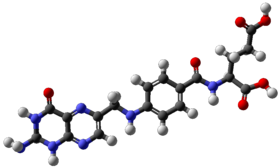Type: Compound
Vitamin: B9
Name: Folic Acid (Folacin),Folinic Acid
RDA:0.4 mg
Importance- to Body:
Basis of coenzymes that act in synthesis of methionine and certain other amino acids, choline, DNA; essential for formation of red blood cells.
Distribution- in Body:
Synthesized by enteric bacteria. The pure vitamin is bright-yellow crystaline compound; stable to heat; easily oxidized in acidic solutions and light; stored mainly in liver.
Excess Effects:
None listed
Deficiency Effects:< br/>
Macrocytic or Megaloblastic Anemia; Gastrointestinal Disturbances, Diarrhea
Food Sources:
Liver, Deep-Green Vegetables, Yeast, Lean Beef, Eggs, Veal, Whole Grains
Environmental/Geographic Sources:
None listed
Supplemental information:
 |
|
 |
|
| Clinical data | |
|---|---|
| Pronunciation | foe' lik |
| Synonyms | FA, N-(4-{[(2-amino-4-oxo-1,4-dihydropteridin-6-yl)methyl]amino}benzoyl)-L-glutamic acid, pteroyl-L-glutamic acid, vitamin B9, vitamin Bc, vitamin M, folacin, pteroyl-L-glutamate |
| AHFS/Drugs.com | Monograph |
| MedlinePlus | a682591 |
| Pregnancy category |
|
| Routes of administration |
By mouth, IM, IV, sub-Q |
| ATC code | |
| Legal status | |
| Legal status |
|
| Pharmacokinetic data | |
| Bioavailability | 50–100% |
| Metabolism | Liver |
| Excretion | Urine |
| Identifiers | |
|
|
| CAS Number | |
| PubChem CID | |
| IUPHAR/BPS | |
| DrugBank | |
| ChemSpider | |
| UNII | |
| KEGG | |
| ChEBI | |
| ChEMBL | |
| ECHA InfoCard | 100.000.381 |
| Chemical and physical data | |
| Formula | C19H19N7O6 |
| Molar mass | 441.40 g·mol−1 |
| 3D model (JSmol) | |
| Melting point | 250 °C (482 °F) (decomposition) |
| Solubility in water | 1.6 mg/L (25 °C) mg/mL (20 °C) |
|
|
|
|
Folate, distinct forms of which are known as folic acid, folacin, and vitamin B9, is one of the B vitamins. The recommended daily intake of folate in the US is 400 micrograms from foods or dietary supplements. Folate in the form of folic acid is used to treat anemia caused by folic acid deficiency. Folic acid is also used as a supplement by women during pregnancy to prevent neural tube defects (NTD) in the baby. Low levels in early pregnancy are believed to be the cause of more than half of babies born with neural tube defects. More than 50 countries use fortification of certain foods with folic acid as a measure to decrease the rate of NTDs in the population. Long term supplementation is also associated with small reductions in the risk of stroke and cardiovascular disease. It may be taken by mouth or by injection.
There are no common side effects. It is not known whether high doses over a long period of time are of concern. There are concerns that large amounts of folic acid might hide vitamin B12 deficiency. Folic acid is essential for the body to make DNA, RNA, and metabolise amino acids which are required for cell division. As humans cannot make folic acid, it is required from the diet, making it an essential vitamin.
Not consuming enough folate can lead to folate deficiency. This may result in a type of anemia in which low numbers of large red blood cells occur. Symptoms may include feeling tired, heart palpitations, shortness of breath, open sores on the tongue and changes in the color of the skin or hair. Folate deficiency in children may develop within a month of poor dietary intake. In adults, normal total body folate is between 10,000–30,000 micrograms (µg) with blood levels of greater than 7 nmol/L (3 ng/mL).
Folic acid was discovered between 1931 and 1943. It is on the World Health Organization's List of Essential Medicines, the most effective and safe medicines needed in a health system. The wholesale cost of supplements in the developing world is between 0.001 and 0.005 USD per dose as of 2014. The term "folic" is from the Latin word folium, which means leaf. Folates occur naturally in many foods, especially dark green leafy vegetables, liver, and lentils.

